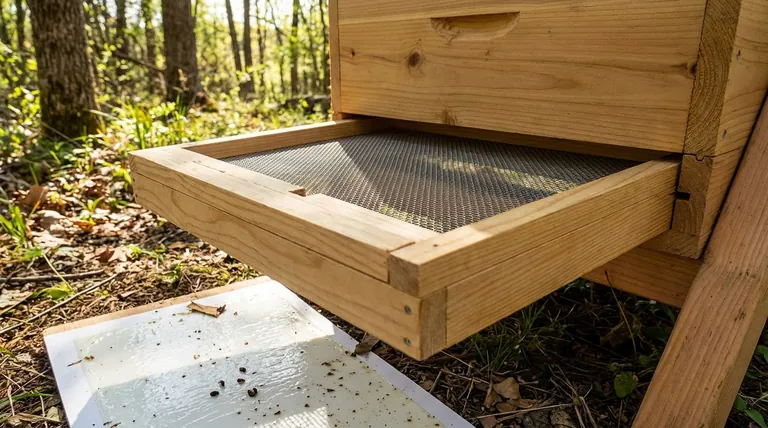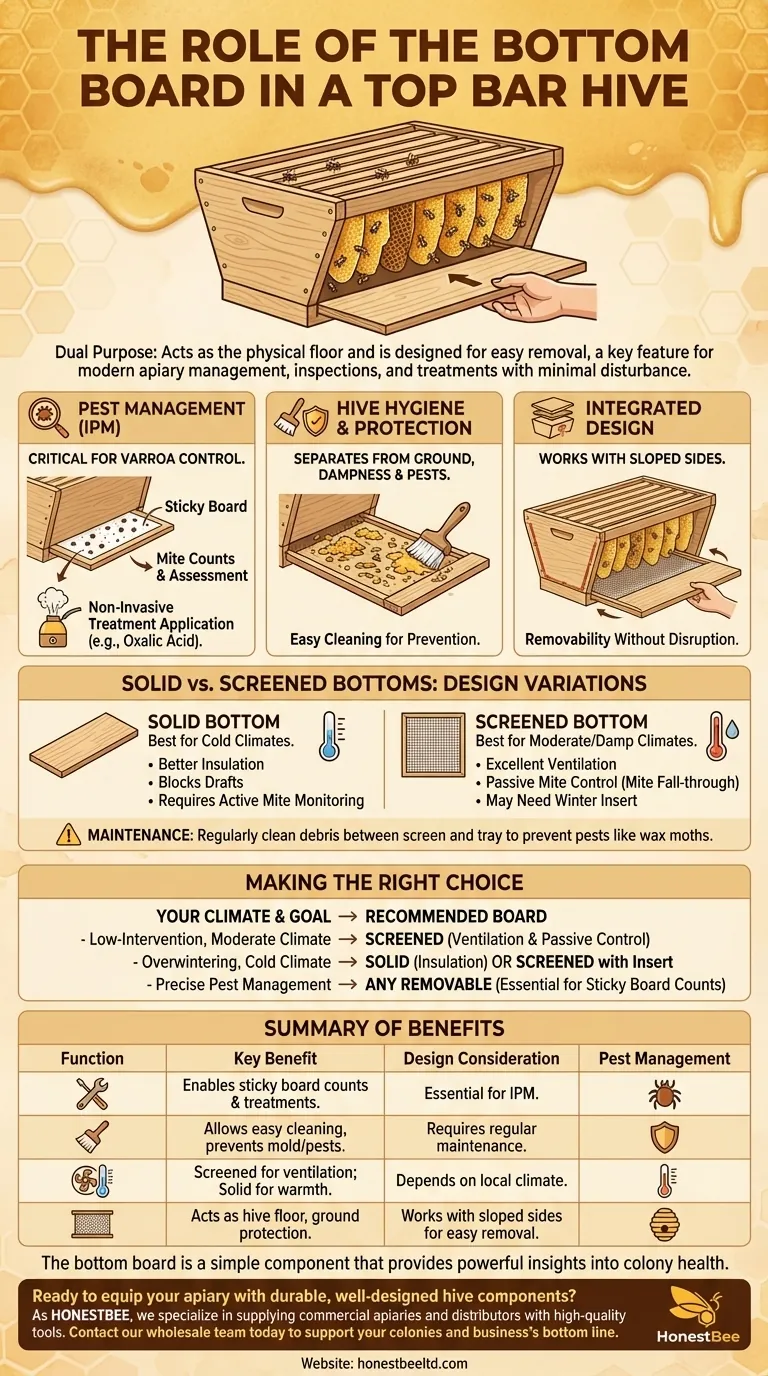In a top bar hive, the bottom board serves a dual purpose: it acts as the physical floor of the hive while being intentionally designed for easy removal. This removability is a key feature for modern apiary management, allowing the beekeeper to inspect for pests like Varroa mites and apply treatments with minimal disturbance to the colony.
The removable bottom board is a critical management tool, not just a structural component. It transforms the floor of the hive into a diagnostic window, enabling the beekeeper to monitor colony health with a level of ease that aligns with the core principles of natural beekeeping.

Deconstructing the Bottom Board's Role
The bottom board is integral to the function and management philosophy of the top bar hive (TBH). Its design supports pest control, hive hygiene, and the unique way bees build comb in this horizontal system.
A Foundation for Pest Management
The most critical function of a removable bottom board is facilitating Integrated Pest Management (IPM), particularly against the Varroa destructor mite.
By sliding the board out, a beekeeper can place a "sticky board" (a sheet coated with a non-toxic sticky substance) underneath the colony. Mites that naturally fall off the bees are caught on the board, allowing for an accurate count and assessment of the infestation level without opening the hive.
This access point is also used for applying treatments. Methods like oxalic acid vaporization can be administered through the bottom opening, ensuring efficient distribution throughout the hive while causing very little stress to the bees.
An Element of the Hive's Integrated Design
The bottom board's removability is only possible because of the overall design of the top bar hive. Unlike a vertically stacked Langstroth hive, a TBH is horizontal.
Most top bar hives, particularly the Kenyan style, have sloped sides. This design feature discourages bees from attaching their naturally hanging comb to the hive walls.
Because the comb hangs freely from the top bars and is not attached to the sides or floor, the bottom board can be slid out without breaking comb or disrupting the colony's structure.
Promoting Hygiene and Protection
As a basic structural element, the bottom board separates the colony from the ground. This protects the bees from dampness, which can lead to mold and disease.
When the hive is raised on legs, the bottom board also provides a barrier against crawling pests. Regular cleaning of debris (like wax cappings and pollen) that collects on the board is a simple but effective hive hygiene practice.
Understanding the Trade-offs and Design Variations
While the concept is simple, the specific design of a bottom board carries important implications for your beekeeping strategy.
Solid vs. Screened Bottoms
Many modern top bar hives feature a screened bottom board instead of a solid one. This consists of a sturdy mesh screen that serves as the permanent floor, with a removable solid board (or tray) underneath it.
A screened bottom provides constant ventilation, which is excellent for humidity control in damp climates. It also provides passive mite control, as some mites will fall through the screen and out of the hive entirely.
However, in cold climates, a screened bottom can create a draft, making it harder for the colony to maintain its cluster temperature in winter. In these regions, a solid bottom board or a screened bottom that can be closed off is often preferred.
Management and Maintenance
A removable board is not a "set it and forget it" component. The space between a screened bottom and the slide-in board can become a haven for pests like wax moths and small hive beetles if not cleaned regularly.
Beekeepers must periodically remove and clean the board of wax debris and other detritus. This simple act removes pest habitats and provides another opportunity to inspect the health of the colony.
Making the Right Choice for Your Goal
Your approach to the bottom board should align with your climate and management style.
- If your primary focus is low-intervention beekeeping in a moderate climate: A screened bottom board offers excellent passive ventilation and some mite control, reducing your day-to-day management tasks.
- If your primary focus is overwintering successfully in a cold climate: A solid, removable bottom board provides better insulation, or a screened version with a tight-fitting insert to block winter drafts.
- If your primary focus is precise pest management: Any removable bottom board that allows for a sticky board mite count is essential. The choice between solid or screened becomes secondary to the ability to monitor infestations accurately.
Ultimately, the bottom board is a simple component that provides powerful insights into the health and habits of your colony.
Summary Table:
| Function | Key Benefit | Design Consideration |
|---|---|---|
| Pest Management | Enables sticky board mite counts & non-invasive treatments. | Essential for Integrated Pest Management (IPM). |
| Hive Hygiene | Allows for easy cleaning of debris to prevent mold & pests. | Requires regular maintenance. |
| Ventilation & Insulation | Screened boards aid ventilation; solid boards aid winter warmth. | Choice depends on your local climate. |
| Structural Support | Acts as the hive floor, protecting the colony from the ground. | Works with sloped sides for easy removal. |
Ready to equip your apiary with durable, well-designed hive components?
As HONESTBEE, we specialize in supplying commercial apiaries and beekeeping equipment distributors with the high-quality tools they need to succeed. Our top bar hive components, including robust bottom boards, are built for effective management and long-term value.
Contact our wholesale team today to discuss your supply needs and discover how our equipment can support the health of your colonies and your business's bottom line.
Visual Guide

Related Products
- Langstroth Screen Bottom Board for Beekeeping Wholesale
- Australian Pine Wood Langstroth Screen Bottom Board for Wholesale
- HONESTBEE Wooden Bee Escape Board with Triangle Mesh Design for Beekeeping
- HONESTBEE Professional Frame Wiring Board and Jig
- Professional Galvanized Hive Strap with Secure Locking Buckle for Beekeeping
People Also Ask
- What is the primary function of a screened bottom board in a hive? Enhance Ventilation & Control Varroa Mites
- What are the benefits of using a screened bottom board for beehives? Improve Ventilation & Mite Control
- What are some considerations when choosing between solid and screened bottom boards? Optimize Hive Health & Pest Control
- What are the benefits of using a screened bottom board in warm or humid climates? Boost Hive Health & Control Pests
- How should the screened bottom board be used throughout the year? A Guide for Healthy Hives



















